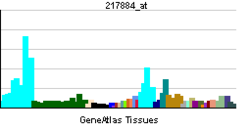- NAT10
-
N-acetyltransferase 10 (GCN5-related) Identifiers Symbols NAT10; ALP; DKFZp434C116; FLJ10774; FLJ12179; FLJ23850; KIAA1709; NET43 External IDs OMIM: 609221 MGI: 2138939 HomoloGene: 6785 GeneCards: NAT10 Gene EC number 2.3.1.- Gene Ontology Molecular function • nucleotide binding
• molecular_function
• protein binding
• ATP binding
• N-acetyltransferase activity
• acyltransferase activity
• transferase activityCellular component • nucleus
• nucleolusBiological process • biological_process
• metabolic processSources: Amigo / QuickGO RNA expression pattern 
More reference expression data Orthologs Species Human Mouse Entrez 55226 98956 Ensembl ENSG00000135372 ENSMUSG00000027185 UniProt Q9H0A0 n/a RefSeq (mRNA) NM_001144030.1 NM_153126.2 RefSeq (protein) NP_001137502.1 NP_694766.1 Location (UCSC) Chr 11:
34.13 – 34.17 MbChr 2:
103.56 – 103.6 MbPubMed search [1] [2] N-acetyltransferase 10 is an enzyme that in humans is encoded by the NAT10 gene.[1][2]
References
- ^ Lv J, Liu H, Wang Q, Tang Z, Hou L, Zhang B (Oct 2003). "Molecular cloning of a novel human gene encoding histone acetyltransferase-like protein involved in transcriptional activation of hTERT". Biochem Biophys Res Commun 311 (2): 506–13. doi:10.1016/j.bbrc.2003.09.235. PMID 14592445.
- ^ "Entrez Gene: NAT10 N-acetyltransferase 10". http://www.ncbi.nlm.nih.gov/sites/entrez?Db=gene&Cmd=ShowDetailView&TermToSearch=55226.
Further reading
- Maruyama K, Sugano S (1994). "Oligo-capping: a simple method to replace the cap structure of eukaryotic mRNAs with oligoribonucleotides.". Gene 138 (1–2): 171–4. doi:10.1016/0378-1119(94)90802-8. PMID 8125298.
- Suzuki Y, Yoshitomo-Nakagawa K, Maruyama K, et al. (1997). "Construction and characterization of a full length-enriched and a 5'-end-enriched cDNA library". Gene 200 (1–2): 149–56. doi:10.1016/S0378-1119(97)00411-3. PMID 9373149.
- Hartley JL, Temple GF, Brasch MA (2001). "DNA Cloning Using In Vitro Site-Specific Recombination". Genome Res. 10 (11): 1788–95. doi:10.1101/gr.143000. PMC 310948. PMID 11076863. http://www.pubmedcentral.nih.gov/articlerender.fcgi?tool=pmcentrez&artid=310948.
- Nagase T, Kikuno R, Hattori A, et al. (2001). "Prediction of the coding sequences of unidentified human genes. XIX. The complete sequences of 100 new cDNA clones from brain which code for large proteins in vitro". DNA Res. 7 (6): 347–55. doi:10.1093/dnares/7.6.347. PMID 11214970.
- Wiemann S, Weil B, Wellenreuther R, et al. (2001). "Toward a Catalog of Human Genes and Proteins: Sequencing and Analysis of 500 Novel Complete Protein Coding Human cDNAs". Genome Res. 11 (3): 422–35. doi:10.1101/gr.GR1547R. PMC 311072. PMID 11230166. http://www.pubmedcentral.nih.gov/articlerender.fcgi?tool=pmcentrez&artid=311072.
- Scherl A, Couté Y, Déon C, et al. (2003). "Functional Proteomic Analysis of Human Nucleolus". Mol. Biol. Cell 13 (11): 4100–9. doi:10.1091/mbc.E02-05-0271. PMC 133617. PMID 12429849. http://www.pubmedcentral.nih.gov/articlerender.fcgi?tool=pmcentrez&artid=133617.
- Strausberg RL, Feingold EA, Grouse LH, et al. (2003). "Generation and initial analysis of more than 15,000 full-length human and mouse cDNA sequences". Proc. Natl. Acad. Sci. U.S.A. 99 (26): 16899–903. doi:10.1073/pnas.242603899. PMC 139241. PMID 12477932. http://www.pubmedcentral.nih.gov/articlerender.fcgi?tool=pmcentrez&artid=139241.
- Ota T, Suzuki Y, Nishikawa T, et al. (2004). "Complete sequencing and characterization of 21,243 full-length human cDNAs". Nat. Genet. 36 (1): 40–5. doi:10.1038/ng1285. PMID 14702039.
- Gerhard DS, Wagner L, Feingold EA, et al. (2004). "The Status, Quality, and Expansion of the NIH Full-Length cDNA Project: The Mammalian Gene Collection (MGC)". Genome Res. 14 (10B): 2121–7. doi:10.1101/gr.2596504. PMC 528928. PMID 15489334. http://www.pubmedcentral.nih.gov/articlerender.fcgi?tool=pmcentrez&artid=528928.
- Wiemann S, Arlt D, Huber W, et al. (2004). "From ORFeome to Biology: A Functional Genomics Pipeline". Genome Res. 14 (10B): 2136–44. doi:10.1101/gr.2576704. PMC 528930. PMID 15489336. http://www.pubmedcentral.nih.gov/articlerender.fcgi?tool=pmcentrez&artid=528930.
- Mehrle A, Rosenfelder H, Schupp I, et al. (2006). "The LIFEdb database in 2006". Nucleic Acids Res. 34 (Database issue): D415–8. doi:10.1093/nar/gkj139. PMC 1347501. PMID 16381901. http://www.pubmedcentral.nih.gov/articlerender.fcgi?tool=pmcentrez&artid=1347501.
- Liu H, Ling Y, Gong Y, et al. (2007). "DNA damage induces N-acetyltransferase NAT10 gene expression through transcriptional activation". Mol. Cell. Biochem. 300 (1–2): 249–58. doi:10.1007/s11010-006-9390-5. PMID 17180247.
- Ewing RM, Chu P, Elisma F, et al. (2007). "Large-scale mapping of human protein–protein interactions by mass spectrometry". Mol. Syst. Biol. 3 (1): 89. doi:10.1038/msb4100134. PMC 1847948. PMID 17353931. http://www.pubmedcentral.nih.gov/articlerender.fcgi?tool=pmcentrez&artid=1847948.
- Chi YH, Haller K, Peloponese JM, Jeang KT (2007). "Histone acetyltransferase hALP and nuclear membrane protein hsSUN1 function in de-condensation of mitotic chromosomes". J. Biol. Chem. 282 (37): 27447–58. doi:10.1074/jbc.M703098200. PMID 17631499.
Categories:- Human proteins
- Chromosome 11 gene stubs
Wikimedia Foundation. 2010.
